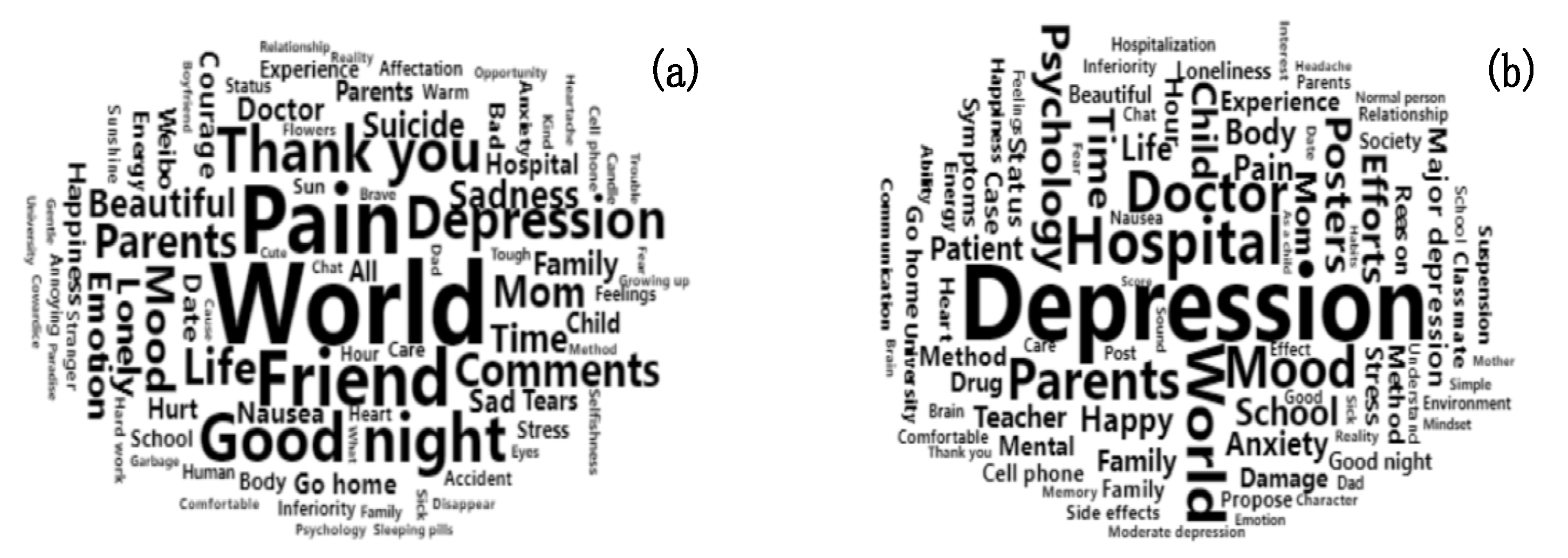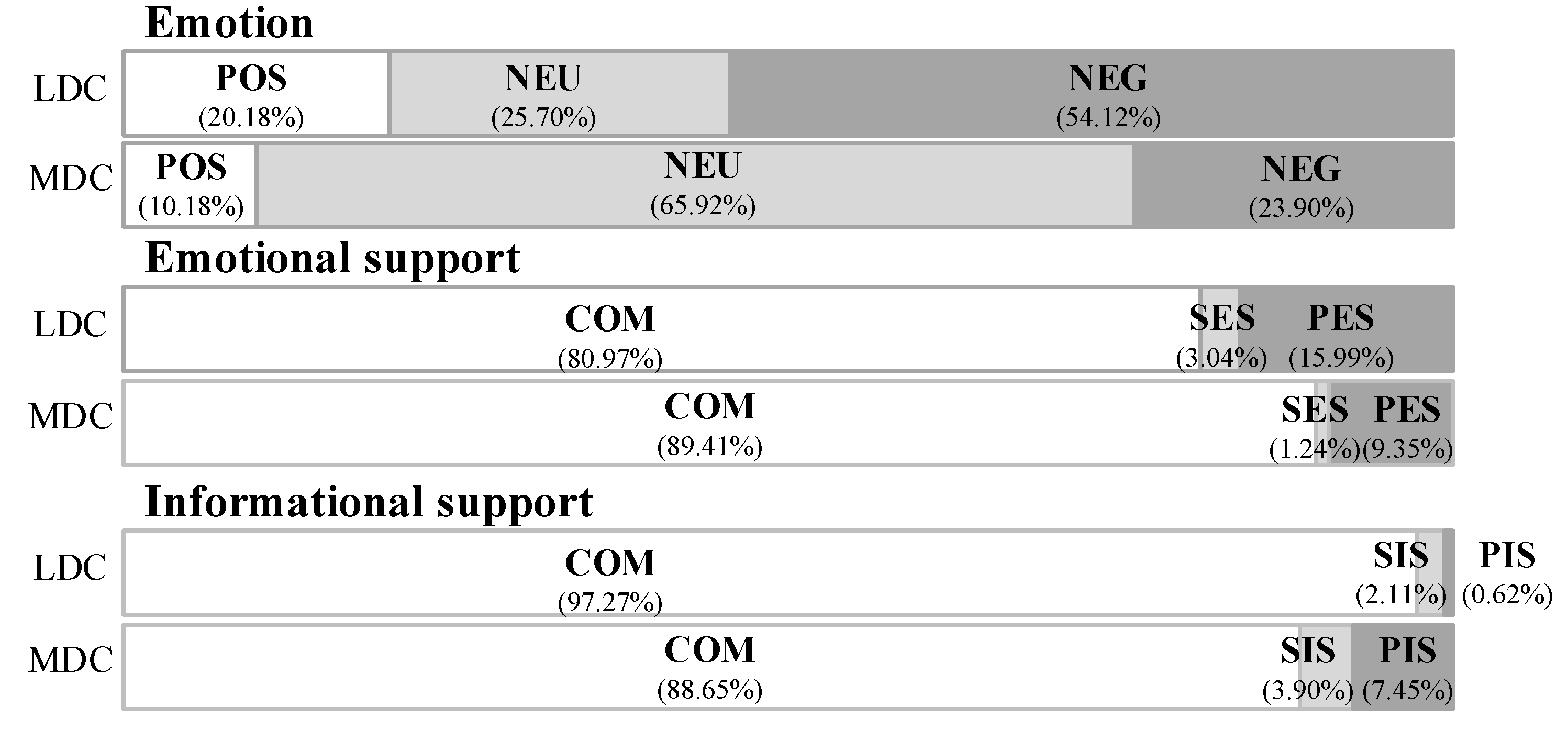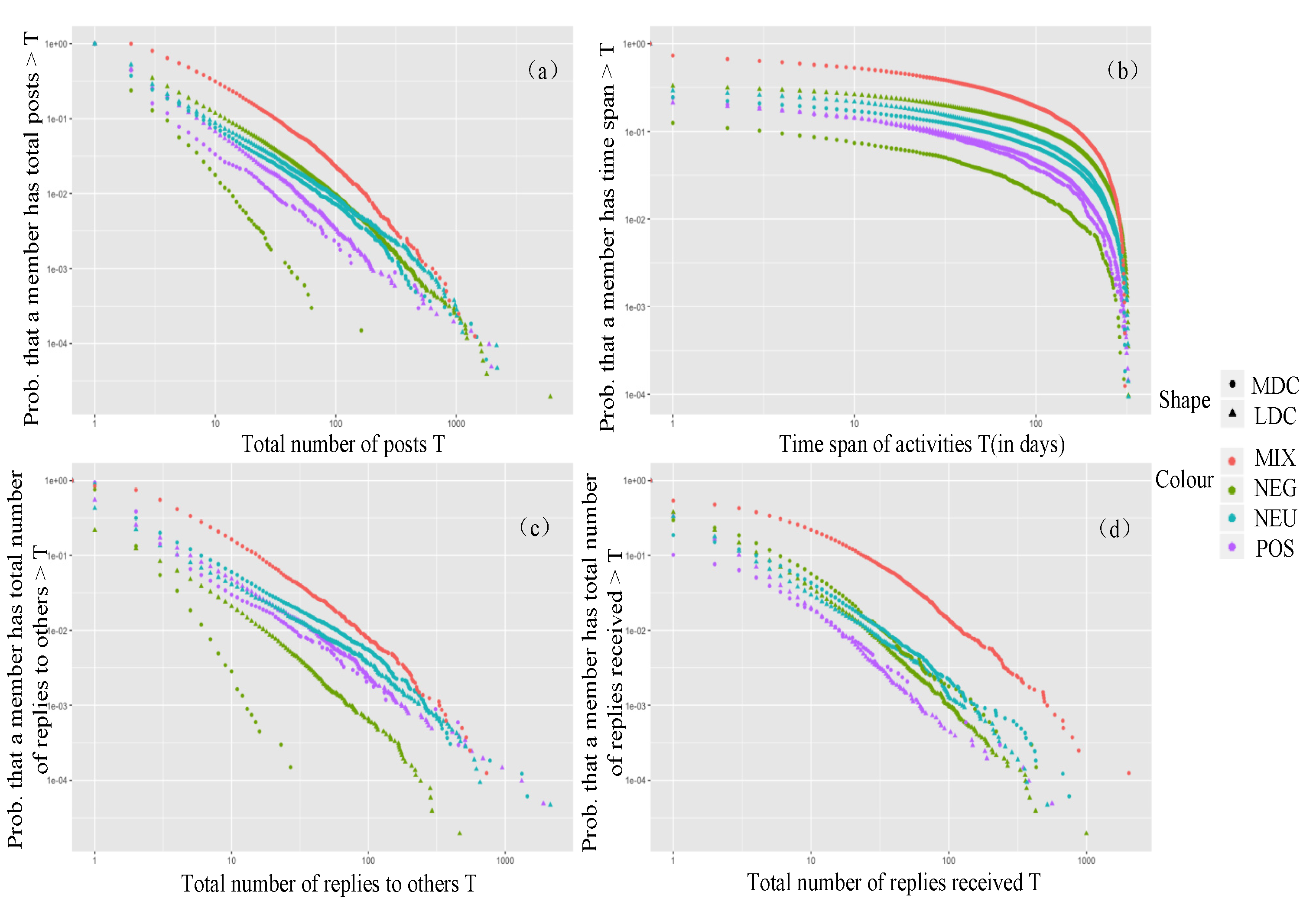A Comparative Study of Online Depression Communities in China
Abstract
:1. Introduction
2. Methods
2.1. Data Collection
2.2. Themes
2.3. Taxonomy of Emotion Expression and Social Support
2.4. Member Profiling
2.5. Participation Pattern
3. Results
3.1. Themes
3.2. Emotion Expression and Social Support in Postings
3.3. Member Profiling
3.4. Participation Patterns
3.4.1. Emotion
3.4.2. Emotional Support
3.4.3. Informational Support
4. Discussion
5. Conclusions
Author Contributions
Funding
Conflicts of Interest
References
- Elise, P.C. A typology of virtual communities: A multi-disciplinary foundation for future research. J. Comput. Mediat. Commun. 2004, 10, JCMC1011. [Google Scholar]
- Sun, Y.; Fang, Y.; Lim, K.H. Understanding sustained participation in transactional virtual communities. Decis. Support Syst. 2012, 53, 12–22. [Google Scholar] [CrossRef]
- World Health Organization. Depression and Other Common Mental Disorders: Global Health Estimates; World Health Organization: Geneva, Switzerland, 2017. [Google Scholar]
- World Health Organization. Depression 2011. Available online: https://www.who.int/mediacentre/multimedia/podcasts/2011/mental_health_17102011/en/ (accessed on 19 October 2011).
- De Choudhury, M.; De, S. Mental Health Discourse on Reddit: Self-Disclosure, Social Support, and Anonymity. In Proceedings of the 8th International Conference on Weblogs and Social Media, Ann Arbor, MI, USA, 2–4 June 2014. [Google Scholar]
- Barney, L.J.; Griffiths, K.M.; Banfield, M.A. Explicit and implicit information needs of people with depression: A qualitative investigation of problems reported on an online depression support forum. BMC Psychiatry 2011, 11, 88. [Google Scholar] [CrossRef] [Green Version]
- Houston, T.K.; Cooper, L.A.; Ford, D.E. Internet support groups for depression:A 1-year prospective cohort study. Am. J. Psychiatry 2002, 159, 2062–2068. [Google Scholar] [CrossRef] [PubMed]
- Powell, J.; McCarthy, N.; Eysenbach, G. Cross-sectional survey of users of Internet depression communities. BMC Psychiatry 2003, 3, 19. [Google Scholar] [CrossRef] [Green Version]
- Griffiths, K.M.; Calear, A.L.; Banfield, M.; Tam, A.; Powell, J. Systematic Review on Internet Support Groups (ISGs) and Depression (2): What Is Known about Depression ISGs? J. Med. Internet Res. 2009, 11, e41. [Google Scholar] [CrossRef]
- Pestello, F.G.; Davis-Berman, J. Taking anti-depressant medication: A qualitative examination of internet postings. J. Ment. Health 2008, 17, 349–360. [Google Scholar] [CrossRef]
- Alexander, S.C.; Peterson, J.L.; Hollingshead, A.B. Help is at your keyboard: Support groups on the Internet. In Group Communication in Context: Studies of Bona Fide Groups; Frey, L.R., Ed.; Routledge: New York, NY, USA, 2003; pp. 309–334. [Google Scholar]
- Muncer, S.; Burrows, R.; Pleace, N.; Loader, B.; Nettleton, S. Births, deaths, sex and marriage… but very few presents? A case study of social support in cyberspace. Crit. Public Health 2000, 10, 1–18. [Google Scholar] [CrossRef]
- Griffiths, K.M.; Calear, A.L.; Banfield, M.; Powell, J. Systematic Review on Internet Support Groups (ISGs) and Depression (1): Do ISGs Reduce Depressive Symptoms? J. Med Internet Res. 2009, 11, e40. [Google Scholar] [CrossRef]
- Eysenbach, G.; Powell, J.; Englesakis, M.; Rizo, C.; Stern, A. Health related virtual communities and electronic support groups: Systematic review of the effects of online peer to peer interactions. BMJ 2004, 328, 1166. [Google Scholar] [CrossRef] [Green Version]
- Lu, Y.; Pan, T.; Deng, S. What Drives Patients Affected by Depression to Share in Online Depression Communities? A Social Capital Perspective. Healthcare 2019, 7, 133. [Google Scholar] [CrossRef] [PubMed] [Green Version]
- Wang, Y.; Kraut, R.E.; Levine, J.M. To stay or leave? The relationship of emotional and informational support to commitment in online health support groups. In Proceedings of the ACM 2012 conference on Computer Supported Cooperative Work, Seattle, WA, USA, 11–15 February 2012; pp. 833–842. [Google Scholar]
- Salem, D.A.; Bogat, G.A.; Reid, C. Mutual help goes on-line. J. Community Psychol. 1997, 25, 189–207. [Google Scholar] [CrossRef]
- Nimrod, G. Online Depression Communities: Members’ Interests and Perceived Benefits. Health Commun. 2013, 28, 425–434. [Google Scholar] [CrossRef] [PubMed]
- Thompson, R.J.; Mata, J.; Jaeggi, S.M.; Buschkuehl, M.; Jonides, J.; Gotlib, I.H. The everyday emotional experience of adults with major depressive disorder: Examining emotional instability, inertia, and reactivity. J. Abnorm. Psychol. 2012, 121, 819–829. [Google Scholar] [CrossRef] [PubMed] [Green Version]
- Hancock, J.T.; Landrigan, C.; Silver, C. Expressing emotion in text-based communication. In Proceedings of the SIGCHI Conference on Human Factors in Computing Systems Empowering People—CHI ’90; Association for Computing Machinery (ACM): New York, NY, USA, 2007; p. 929. [Google Scholar]
- Kramer, A.D. The spread of emotion via facebook. In Proceedings of the CHI’12, Austin, TX, USA, 5–10 May 2012; pp. 767–770. [Google Scholar]
- Coviello, L.; Sohn, Y.; Kramer, A.D.I.; Marlow, C.; Franceschetti, M.; Christakis, N.A.; Fowler, J.H. Detecting Emotional Contagion in Massive Social Networks. PLoS ONE 2014, 9, e90315. [Google Scholar] [CrossRef] [PubMed] [Green Version]
- Sun, C.; Mu, C.; Li, X. A weighted LS-SVM approach for the identification of a class of nonlinear inverse systems. Sci. China Ser. F Inf. Sci. 2009, 52, 770–779. [Google Scholar] [CrossRef]
- Tian, X.; Batterham, P.J.; Song, S.; Yao, X.; Yu, G. Characterizing Depression Issues on Sina Weibo. Int. J. Environ. Res. Public Health 2018, 15, 764. [Google Scholar] [CrossRef] [Green Version]
- Yao, X.; Yu, G.; Tian, X.; Tang, J. Patterns and Longitudinal Changes in Negative Emotions of People with Depression on Sina Weibo. Telemed. e-Health 2019. [Google Scholar] [CrossRef]
- Settanni, M.; Marengo, D. Sharing feelings online: Studying emotional well-being via automated text analysis of Facebook posts. Front. Psychol. 2015, 6, 1045. [Google Scholar] [CrossRef] [Green Version]
- Cavazos-Rehg, P.; Krauss, M.J.; Sowles, S.; Connolly, S.; Rosas, C.; Bharadwaj, M.; Bierut, L.J. A content analysis of depression-related Tweets. Comput. Hum. Behav. 2016, 54, 351–357. [Google Scholar] [CrossRef] [Green Version]
- De Choudhury, M.; Counts, S.; Horvitz, E. Social media as a measurement tool of depression in populations. In Proceedings of the 5th Annual ACM Web Science Conference; Association for Computing Machinery (ACM): New York, NY, USA, 2013; pp. 47–56. [Google Scholar]
- Seabrook, E.; Kern, M.L.; Fulcher, B.D.; Rickard, N.S.; Colditz, J.; Larsen, M.; Soron, T.R.; Arroyo-Gallego, T. Predicting Depression From Language-Based Emotion Dynamics: Longitudinal Analysis of Facebook and Twitter Status Updates. J. Med Internet Res. 2018, 20, e168. [Google Scholar] [CrossRef] [PubMed] [Green Version]
- Myrick, J.G.; Holton, A.E.; Himelboim, I.; Love, B. #Stupidcancer: Exploring a Typology of Social Support and the Role of Emotional Expression in a Social Media Community. Health Commun. 2015, 31, 1–10. [Google Scholar] [CrossRef]
- Shumaker, S.A.; Brownell, A. Toward a Theory of Social Support: Closing Conceptual Gaps. J. Soc. Issues 1984, 40, 11–36. [Google Scholar] [CrossRef]
- Howell, E.A.; Mora, P.A.; DiBonaventura, M.D.; Leventhal, H. Modifiable factors associated with changes in postpartum depressive symptoms. Arch. Women’s Ment. Heal. 2009, 12, 113–120. [Google Scholar] [CrossRef] [PubMed]
- Wang, X.; Zhao, K.; Street, W.N. Social Support and User Engagement in Online Health Communities. Intell. Tutor. Syst. 2014, 8549, 97–110. [Google Scholar]
- Uchino, B.N.; Cacioppo, J.T.; Kiecoltglaser, J.K. The relationship between social support and physiological processes: A review with emphasis on underlying mechanisms and implications for health. Psychol. Bull. 1996, 119, 488–531. [Google Scholar] [CrossRef]
- Eysenbach, G. Medicine 2.0: Social Networking, Collaboration, Participation, Apomediation, and Openness. J. Med. Internet Res. 2008, 10, e22. [Google Scholar] [CrossRef]
- Yang, H.; Guo, S.; Wu, T. Exploring the influence of the online physician service delivery process on patient satisfaction. Decis. Support Syst. 2015, 78, 113–121. [Google Scholar] [CrossRef]
- Bartlett, Y.K.; Coulson, N. An investigation into the empowerment effects of using online support groups and how this affects health professional/patient communication. Patient Educ. Couns. 2011, 83, 113–119. [Google Scholar] [CrossRef]
- Setoyama, Y.; Yamazaki, Y.; Namayama, K.; Bender, J. Benefits of Peer Support in Online Japanese Breast Cancer Communities: Differences Between Lurkers and Posters. J. Med. Internet Res. 2011, 13, e122. [Google Scholar] [CrossRef]
- Van Uden-Kraan, C.; Drossaert, C.; Taal, E.; Seydel, E.; Van De Laar, M. Participation in online patient support groups endorses patients’ empowerment. Patient Educ. Couns. 2009, 74, 61–69. [Google Scholar] [CrossRef] [PubMed]
- Charlson, F.J.; Baxter, A.; Cheng, H.G.; Shidhaye, R.; Whiteford, H.A. The burden of mental, neurological, and substance use disorders in China and India: A systematic analysis of community representative epidemiological studies. Lancet 2016, 388, 376–389. [Google Scholar] [CrossRef]
- Phillips, M.R.; Zhang, J.; Shi, Q.; Song, Z.; Ding, Z.; Pang, S.; Li, X.; Zhang, Y.; Wang, Z. Prevalence, treatment, and associated disability of mental disorders in four provinces in China during 2001–2005: An epidemiological survey. Lancet 2009, 373, 2041–2053. [Google Scholar] [CrossRef]
- Sina Weibo Data Center. Weibo User Development Report; Sina Weibo: Beijing, China, 2013. [Google Scholar]
- Li, G.; Zhou, X.; Lu, T.; Yang, J.; Gu, N. SunForum: Understanding Depression in a Chinese Online Community. In Proceedings of the 19th ACM Conference on Computer-Supported Cooperative Work & Social Computing—CSCW ’16; Association for Computing Machinery (ACM): New York, NY, USA, 2016; pp. 514–525. [Google Scholar]
- Niu, P.; Huang, D. TF-IDF and rules based automatic extraction of Chinese keywords. J. Chin. Comput. Syst. 2016, 37, 711–715. [Google Scholar]
- Slowak, A.P.; Taticchi, P. Technology, policy and management for carbon reduction: A critical and global review with insights on the role played by the Chinese Academy. J. Clean. Prod. 2015, 103, 601–619. [Google Scholar] [CrossRef]
- Devlin, J.; Chang, M.-W.; Lee, K.; Toutanova, K. BERT: Pre-training of Deep Bidirectional Transformers for Language Understanding. arXiv 2018, arXiv:1810.04805v2. Available online: https://arxiv.org/abs/1810.04805 (accessed on 11 October 2018).
- Charrad, M.; Ghazzali, N.; Boiteau, V.; Niknafs, A. NbClust: An R Package for Determining the Relevant Number of Clusters in a Data Set. J. Stat. Softw. 2014, 61, 2–36. [Google Scholar] [CrossRef] [Green Version]
- Wang, Z.; Yu, G.; Tian, X. Exploring Behavior of People with Suicidal Ideation in a Chinese Online Suicidal Community. Int. J. Environ. Res. Public Health 2018, 16, 54. [Google Scholar] [CrossRef] [Green Version]
- Hatfield, E.; Cacioppo, J.T.; Rapson, R.L. Emotional Contagion. Emot. Contag. 1993, 2, 96–99. [Google Scholar] [CrossRef]
- Rosenquist, J.N.; Fowler, J.H.; A Christakis, N. Social network determinants of depression. Mol. Psychiatry 2010, 16, 273–281. [Google Scholar] [CrossRef] [Green Version]
- Kramer, A.D.I.; Guillory, J.E.; Hancock, J.T. Experimental evidence of massive-scale emotional contagion through social networks. Proc. Natl. Acad. Sci. USA 2014, 111, 8788–8790. [Google Scholar] [CrossRef] [PubMed] [Green Version]
- Hancock, J.T.; Gee, K.; Ciaccio, K.; Lin, J.M.-H. I’m sad you’re sad. In Proceedings of the the ACM 2008 Conference; Association for Computing Machinery (ACM): New York, NY, USA, 2008; pp. 295–298. [Google Scholar]
- Swan, M. Emerging Patient-Driven Health Care Models: An Examination of Health Social Networks, Consumer Personalized Medicine and Quantified Self-Tracking. Int. J. Environ. Res. Public Health 2009, 6, 492–525. [Google Scholar] [CrossRef] [PubMed]
- Hartzler, A.; Pratt, W.; Adams, S.; Frost, J. Managing the Personal Side of Health: How Patient Expertise Differs from the Expertise of Clinicians. J. Med. Internet Res. 2011, 13, e62. [Google Scholar] [CrossRef] [PubMed]






| Community | Emotion | Emotional Support | Informational Support | |||
|---|---|---|---|---|---|---|
| Type | Proportion | Type | Proportion | Type | Proportion | |
| LDC | POS | 20.03% | COM | 80.28% | COM | 96.24% |
| NEU | 50.48% | SES | 3.11% | SIS | 2.72% | |
| NEG | 29.59% | PES | 16.61% | PIS | 1.04% | |
| MDC | POS | 11.76% | COM | 87.31 | COM | 89.01% |
| NEU | 62.14% | SES | 1.92% | SIS | 4.28% | |
| NEG | 26.10 | PES | 10.77% | PIS | 6.71% | |
| Community | Emotion (%) | Emotional Support (%) | Informational Support (%) | |||
|---|---|---|---|---|---|---|
| Accuracy | F1 score | Accuracy | F1 score | Accuracy | F1 score | |
| LDC | 94.48 | 96.52 | 93.38 | 84.79 | 97.58 | 74.56 |
| MDC | 86.67 | 81.83 | 95.10 | 81.36 | 95.57 | 81.00 |
| Emotion | |||
| Centroids (NEU, POS, NEG) | Type | Proportion (Number) | |
| LDC | <0.049, 0.034, 0.917> | Negative emotional group | 55.67% (51,487) |
| <0.768, 0.086, 0.146> | Neutral emotional group | 23.11% (21,342) | |
| <0.037, 0.853, 0.109> | Positive emotional group | 22.21% (20,509) | |
| MDC | <0.969, 0.017, 0.013> | Neutral emotional group | 48.90% (16,377) |
| <0.532, 0.066, 0.402> | Mixed emotional group | 23.99% (8033) | |
| <0.016, 0.005, 0.979> | Negative emotional group | 20.01% (6701) | |
| <0.136, 0.8241, 0.040> | Positive emotional group | 10.09% (3378) | |
| Emotional support | |||
| Centroids (COM, SES, PES) | Type | Proportion (number) | |
| LDC | <0.979, 0.0101, 0.011> | Companionship group | 72.46% (66,905) |
| <0.015, 0.001, 0.984> | Emotional support providers | 14.01% (12,940) | |
| <0.558, 0.023, 0.420> | Mixed group | 11.72% (10,822) | |
| <0.174, 0.800, 0.027> | Emotional support seekers | 2.89% (2671) | |
| MDC | <0.985, 0.003, 0.012> | Companionship group | 85.30% (28,565) |
| <0.516, 0.186, 0.298> | Mixed group | 10.33% (3461) | |
| <0.024, 0.001, 0.975> | Emotional support providers | 7.35% (2463) | |
| Informational support | |||
| Centroids (COM, SIS, PIS) | Type | Proportion (number) | |
| LDC | <0.996, 0.003, 0.001> | Companionship group | 96.42% (89,034) |
| <0.668, 0.309, 0.022> | Mixed group | 2.88% (2659) | |
| <0.011, 0.989, 0.0001> | Informational support seekers | 1.34% (1234) | |
| <0.208, 0.011, 0.781> | Informational support providers | 0.45% (411) | |
| MDC | <0.962, 0.016, 0.022> | Companionship group | 85.57% (28,656) |
| <0.175, 0.034, 0.791> | Informational support providers | 9.21% (3085) | |
| <0.141, 0.852, 0.007> | Informational support seekers | 8.21% (2748) | |
© 2020 by the authors. Licensee MDPI, Basel, Switzerland. This article is an open access article distributed under the terms and conditions of the Creative Commons Attribution (CC BY) license (http://creativecommons.org/licenses/by/4.0/).
Share and Cite
Tang, J.; Yu, G.; Yao, X. A Comparative Study of Online Depression Communities in China. Int. J. Environ. Res. Public Health 2020, 17, 5023. https://0-doi-org.brum.beds.ac.uk/10.3390/ijerph17145023
Tang J, Yu G, Yao X. A Comparative Study of Online Depression Communities in China. International Journal of Environmental Research and Public Health. 2020; 17(14):5023. https://0-doi-org.brum.beds.ac.uk/10.3390/ijerph17145023
Chicago/Turabian StyleTang, Jingyun, Guang Yu, and Xiaoxu Yao. 2020. "A Comparative Study of Online Depression Communities in China" International Journal of Environmental Research and Public Health 17, no. 14: 5023. https://0-doi-org.brum.beds.ac.uk/10.3390/ijerph17145023





